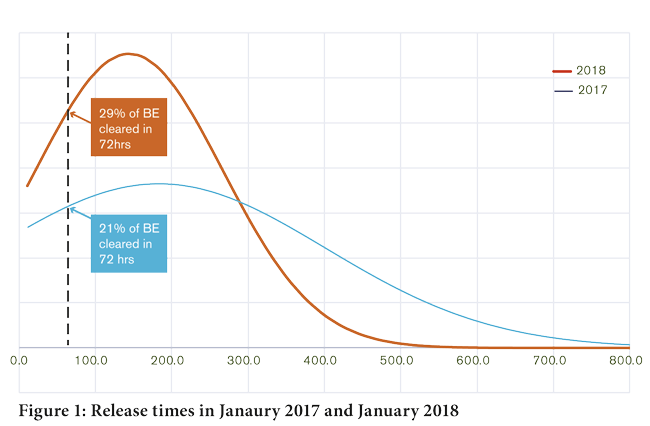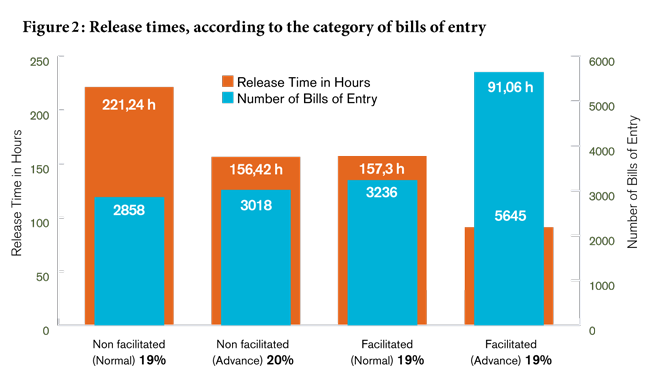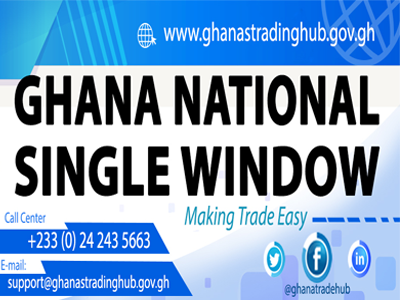Assessing the clearance process: India shares its experience
20 June 2018
By Vijay Singh Chauhan, Commissioner of Customs, Jawaharlal Nehru Custom House, IndiaThe importance of the Time Release Study (TRS) has long been emphasized by the WCO as a useful tool for Customs administrations across the world to assess their performance in terms of the clearance process. Jawaharlal Nehru Custom House, catering to Jawaharlal Nehru Port Trust (JNPT), India’s biggest containerized port, has been conducting such studies[1] since 2013 as per the WCO’s guidelines. This article presents the results drawn from the latest study, highlighting the impact of facilitation schemes on goods release times.
The largest Customs house in the country, Jawaharlal Nehru Custom House (JNCH), accounting for about 21% of national Customs revenue, has been at the forefront of implementing various trade facilitation measures defined by the Central Board of Indirect Taxes and Customs (CBIC) as well as attempting innovative local initiatives to improve the ease of doing business.
It is worth reminding readers here of India’s trade facilitation agenda. The country aims not only to meet the requirements of the World Trade Organization’s Trade Facilitation Agreement (TFA) which entered into force in 2017, but also to become a global manufacturing hub by improving the ease of doing business. Many of the goals listed in India’s National Trade Facilitation Action Plan (NTFAP), drawn up to fulfil national commitments under the TFA, go beyond the TFA provisions. The idea is to bring down the overall cargo release time for imports and exports as follows:
- for imports – within three days for sea cargo, within two days for air cargo and inland container depots, and on the same day for land Customs stations.
- for exports – within two days for sea cargo, and on the same day for air cargo, inland container depots, and land Customs stations.
- spread awareness about time release among all stakeholders, and their role in its reduction;
- measure the distance to the target release times set out in the NTFAP;
- identify categories of bills of entry (Customs declarations), commodities and sub-processes that are relatively more time-consuming, with a view to suggesting measures to improve time releases relating thereto;
- improve coordinated border management by seeking to estimate release times associated with different partner agencies;
- assess the impact of statutory and administrative changes on trade behaviour over time;
- present a first set of time release data for export cargo through the JNCH; and
- build the capacity of officers.
One major decision was to conduct the study in-house, with the cooperation of all stakeholders, including importers, Customs brokers, and other government agencies. In a break from the earlier TRS’s, which were based on ex-post statistical analysis, TRS 2018 was conducted as a “live” sensitization-cum-learning exercise under the “Best Foot Forward” slogan. Emphasis was placed on doing things efficiently, without compromising due diligence, as expected of Customs and other regulatory agencies.
It could be argued that conducting a “live” TRS might impact actual performance. We did recognise the concerns posed by this mechanism, however, guided by the substantive benefit in terms of sensitization of various stakeholders, we went ahead with the same, confident that our results do not suffer from any bias.
In terms of data sources, the study relied primarily on the time stamps in the Customs information technology (IT) system, as in earlier studies. However, for the first time, other data sources from the port terminals, container freight stations (CFSs), participating government agencies (PGAs), such as the Food Safety and Standards Authority, the Drug Controller, the Textiles Committee and the Chemical Laboratory, were also utilized. These agencies were happy to participate in the study. Their recommendations were included in the study, and the efforts of their staff were duly recognized along with those of the Customs officers.
In addition, a small sample of bills of entry and shipping bills (import and export Customs declarations) were tracked “live” through the concerned Customs brokers. In fact, the results of the exports TRS are based on such “live” tracking, given that the time-stamps in the Customs IT system do not appropriately capture the export process.
Methodology for imports
The study analyzed all 14,973 bills of entry (import declarations) lodged during the sample period, viz. from 1 to 7 January 2018, and tracked them till 7 February 2018. The standard WCO definition of time release is the time taken from arrival of the goods at the port to its eventual release by Customs. For this study, the arrival time is approximated by the grant of entry inwards of the vessel, and the release time by the grant of out of charge by Customs. This release time includes the time taken by all government agencies, including Customs.
However, the study also quantified the time from berthing of the vessel at the JNPT to the grant of entry inwards by correlating data from the terminal operating system and the Customs system in respect of all 46 vessels that berthed at the port. It showed that the average time was 31 minutes. Further, comparing the data from the Customs system with that from five CFSs, the time taken from “out of charge” given by Customs to “gate out” by the importers was found to be 35.4 hours.
The standard time release analysis is, however, based on the time taken from entry inwards to out of charge. Moreover, 216 bills of entry (1.4%) were excluded for three sets of reasons: (i) in 57 cases, goods had not yet arrived by 7 February 2018; (ii) 134 cases were pending at various stages of clearance; and (iii) 25 bills of entry were filed more than 60 days after the arrival of the goods.
The import release time was calculated in respect of various categories of bills of entry, with the intention to highlight various aspects of clearance processes, and to test various hypotheses formed on the basis of day-to-day working activities at the JNCH. Some of the major categories are discussed below.
The all-in-one average release time for bills of entry was found to have declined from 181 hours in January 2017 to 144 hours in 2018. It shows that the distance to the NTFAP target of 72 hours is still significant. The “essence of the effort” representing the overall improvement in the release time since Janaury 2017 was captured in the normal distribution given in figure 1, showing, inter alia, that a higher number of consignments, i.e. 29% as against 21% in 2017, were cleared in less than 72 hours, and very few consignments took longer than 400 hours.

The bill of entry with a minimum release time of 11.01 hours was identified, highlighting the four features that form the core of the drive to reach the NTFAP target, namely (a) a higher share of advance bills of entry to enable pre-arrival processing, (b) a greater level of facilitation, (c) more authorized economic operator (AEO) enrolment, and (d) higher direct port delivery (DPD) clearances. The DPD scheme allows importers/consignees to take delivery of containers directly from port terminals and haul them to factories without first having to take them to CFSs.
The study captured the improvement in the share of pre-arrival processing and facilitation levels in 2018 over 2017. The disaggregated and stratified release time data in this regard, as presented in figure 2, is being utilised to drive home the outreach message that despite the fact that advance bills of entry have about 40% lower release time, 40% of the bills of entry were not filed in advance.

AEO and DPD are two categories of clients who are accorded preferred treatment in the cargo clearance process. In order to highlight the benefits to them in terms facilitation and/or release time, disaggregated release times in respect of these bills of entry were presented. They showed that 84.6% of bills of entry submitted by AEOs enjoyed higher full facilitation benefits while only 60.2% of the overall bills of entry did, and that the average release time was 103.06 hours vis-à-vis an overall average of 144 hours. With 75.1% of DPDs enjoying full facilitation benefits, the average release time for DPD advance facilitated bills of entry was 65.36 hours.
The study identified six categories of commodities based on specific requirements associated with them to highlight their impact on the release time. As part of this exercise, the release time for auto components was computed for comparison with the data presented by the World Bank in its Ease of Doing Business index. Although the World Bank study found that the release time for auto components imported from South Korea was 267 hours, this is more than double the release time of 126.54 hours under TRS 2018. The release time data for auto component imports from South Korea was used to highlight the benefits of various facilitation measures as the “path to promptness,” as can be seen in figure 3.

The issues pertaining to other regulatory agencies participating in the Single Window initiative of the CBIC were highlighted by presenting the disaggregated release time in respect of bills of entry processed by these agencies. This has highlighted the importance of streamlining the processes associated with the clearance of these goods from the point of view of non-revenue regulations.

The study also enabled the responses of importers to three specific measures to reduce release times to be analyzed. It was found that during the period from January 2017 to January 2018: (a) the share of advance filing of bills of entry, allowing for pre-arrival processing, increased from 53.3 to 58.7%; (b) prompt filing of normal bills of entry, as measured by those filing normal bills of entry within 48 hours of entry inwards, increased from 48 to 79%; and (c) prompt payment of duty, as measured by those paying duty within 48 hours of the assessment, increased from 42 to 46%. These findings revealed a significant compliance gap that has been taken up for further analysis.
Methodology for exports
The gross export release time, measured from the time of departure of cargo from the factory premises to the departure of the vessel and net export release time by excluding the domestic transport time, were presented in respect of six major categories of goods: (i) frozen meat, (ii) frozen fish, (iii) pharmaceuticals, (iv) automobile parts, (v) two and three wheelers (bikes, auto rickshaws), and (vi) electrical machinery (falling under chapter 85 of the Harmonized System nomenclature). This was computed, based on a sample survey among the five top exporters in respect of each of the six categories.
The gross average export release time was found to be 108 hours and the net average export release time was 84.1 hours. This is broadly in line with the World Bank’s Ease of Doing Business Report 2018 finding of an export release time of about 85 hours. There is significant variation in the average export release time, according to the type of commodity being exported, with a net average export release time of 53.4 hours for frozen meat and 99.7 hours for electrical machinery. The stage-wise analysis of the export process, as shown in figure 5, highlighted that a large share of time is taken after cargo enters the terminal premises.

Conclusions and challenges
The study has enabled the CBIC to make many short term and long term suggestions and recommendations to further reduce release times, which calls for actions on the part of all stakeholders, and entails process improvements, outreach, and the upgrading of physical infrastructure.
The conduct of TRS 2018 was a challenge given the new grounds that were traversed and the large number of people, representing various stakeholders, who worked as part of the team. Regarding exports especially, the rate and quality of the responses provided by the targeted exporters to the sample surveys were not very encouraging. But, the study has been a learning experience, and is expected to contribute to an even better study next year.
More information
chauhan@nic.in
vschauhan67@hotmail.com
[1] These studies can be accessed at http://www.jawaharcustoms.gov.in/pdf/TRS2018-Jan-June.pdf

